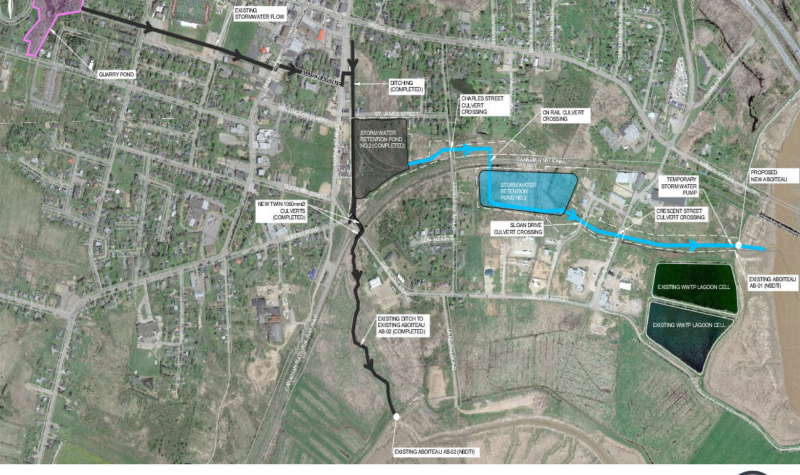The final phase of the Lorne Street Floodwater Mitigation project may be approved for funding, but there’s one more hurdle to clear before the project will move forward as planned: the New Brunswick Department of Transportation and Infrastructure (DTI) needs to agree to build a new, bigger aboiteau to drain into the Tantramar River.
When, how and if they will could be decided in a meeting slated for next week.
Englobe (formerly Crandall Engineering) engineer Pierre Plourde came to town hall Tuesday night to update councillors on the state of the project, and stress the importance of gaining the cooperation of DTI. The current aboiteau—which allows freshwater to drain into the Tantramar River while keeping saltwater tides out—is undersized, said Plourde, and that’s been known for many years, throughout the life of the stormwater project.
“It was built in the 1900s, so it’s too small to be able to take the water between the tide cycles and evacuate the water,” said Plourde. “So that aboiteau is in need of a major upgrade.”
Plourde says that in previous phases of the project, DTI has been receptive to the idea of replacing the aboiteau, but the lack of funding meant further progress was delayed. Now that just over $4 million in federal and provincial funding (plus just under $1.5 million from the town of Sackville) has been approved, it’s become much more important to know what DTI is planning.
“That’s going to affect how we’re going to do the design for the pond number three,” Plourde told council. “Are we able to discharge in 2023? Is it planned for 2024? So once we know they’re planning, we’ll be able to adjust our design accordingly.”
The third phase of the plan includes two more freshwater retention ponds which will more than double the storage capacity currently in place at the as-yet-unnamed Lorne Street pond. One is at the old Pickard Quarry nestled in the woods between York, Salem and Charlotte Streets. Another, dubbed Pond #3, is behind the Community Garden on Charles Street which would be connected by ditches and culverts to a potential new DTI aboiteau.
Plourde says a meeting is scheduled for July 13 in Sackville with Minister Jill Green of DTI and Minister Gary Crossman of Environment and Climate Change. The ministers will come to Sackville town hall for a presentation, and then go for a site visit.
FULL STEAM AHEAD ON QUARRY POND
In the meantime, there are other aspects of the plan that can move forward even before the future of the aboiteau is determined.
The first pond slated to be built is in the Pickard Quarry. This part of the project was originally slated to happen earlier, so the design and permitting is already complete.
Plourde told council that as soon as Mount Allison University, who own the land, signs off on a sale, a tender can go out, and the work could be completed over the winter.
“It’s an important part in the overall strategy because a lot of the water comes from there,” says Plourde. “If we can restrict a good amount of water there, it helps downstream, right. That’s really high in elevation compared to where we are [at town hall], and there’s limited work to be done.”
Plourde says the good news about using quarry pond as part of the stormwater retention system is that the ponds already exist, and the work that needs to be done is minimal compared to the Lorne and Charles Street ponds. “We just need to put the infrastructure to be able to retain the water,” said Plourde.
GETTING BLOOD FROM A STONE?
The project also includes drainage ditching which will cross CN rail tracks. Coun. Sabine Dietz asked Plourde if CN would be cost sharing the replacement of the culverts that protect its tracks, but Plourde told council municipalities are typically on the hook for full costs. He did, however, say he could always put in a request.
Dietz felt a request to co-fund the culvert upgrades is justified. “After all, if they’re in bad shape, it’s their infrastructure, and it creates problems for the town… So I think it should be possible to get CN to pay some of this.”
Coun. Bill Evans then weighed in jokingly to say, “the expression blood from a stone comes to mind, but good luck.”
CAO Jamie Burke told council that after the meeting with ministers Jill Green and Gary Crossman next week, staff would report back to council in a public forum.
Listen to the CHMA story below:


